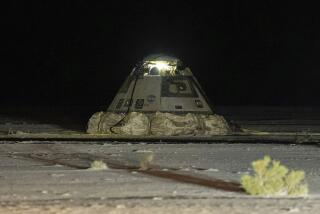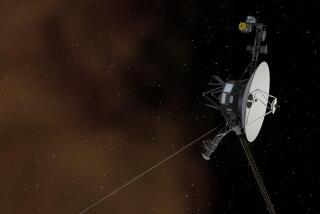Voyager Flies Home, Lands in the Pages of Air History : 26,000-Mi. Trip Ends at Air Base
- Share via
EDWARDS AIR FORCE BASE — Dick Rutan and Jeana Yeager took their place in aviation history today as they brought the Voyager home in a triumph of physical stamina and personal courage.
The storm-battered plane touched down at Edwards Air Force Base shortly after 8 a.m., almost exactly nine days after it left on a round-the-world odyssey that ranks among the premier achievements of aviation.
It completed its journey of some 26,000 miles without stopping or refueling, an unprecedented feat. The trip lasted 9 days, 3 minutes and 44 seconds, and averaged 115 m.p.h.
“It’s a great adventure,” Rutan said at a late morning press conference here.
“No telling what we’ll do next,” a smiling Yeager said.
Thousands Cheer
The Voyager was accompanied by several chase planes as it circled over the landing field to the cheers of thousands of greeters, many of them in tears.
“I’m amazed,” Rutan said as the small plane circled the airfield during its final descent.
“Go get it boy, this is your big one, the one you’ve been training for,” Burt Rutan, the pilot’s brother and the Voyager’s designer, radioed from one of the chase planes.
“Yeah, the big one,” Rutan replied nonchalantly.
During the final descent, it took Yeager about 15 minutes to crank down the landing gears, and Rutan kicked up a little dust as he set the ungainly Voyager down on the desert floor.
“It wasn’t the best landing I’ve made, but I walked away from it,” he said, recalling the old pilot’s axiom that any landing is a good one if one can walk away from it.
Thumbs Up
As the plane rolled to a stop in front of a press corps that numbered in the hundreds, Rutan gave a thumbs-up sign and donned his cowboy hat.
The two pilots, stiff and bruised from being jostled around the tiny cabin in a series of fierce storms, cautiously pulled themselves up and sat on top of the plane several minutes before trying their first steps in nine days.
“How wobbly do you feel?” Rutan was asked as he sat on the cockpit cowl.
“A little bit,” he replied, adding a minute later, “I want to sit here for a while, doc.”
Both he and Yeager appeared to be in reasonably good condition, although they each leaned on friends and relatives as they walked a few feet to waiting ambulances for a short ride to the base hospital for a medical checkup.
“It’s really great to be here. I’m really overwhelmed at all the people,” Rutan said. “At times I didn’t think it was going to be successful.”
Rear Engine Died
The nationally televised landing came just hours after a near-disaster when the Voyager’s rear engine--the only one running at the time--suddenly died while the plane was over the Pacific Ocean off Baja California, about 450 miles short of its goal.
The spindly craft plunged 3,500 feet as Rutan and Yeager struggled to start the balky front engine. By the time the forward engine came back to life, the plane had dropped to an altitude of 5,000 feet. The front engine had been shut off hours earlier to conserve fuel.
According to Lee Herron, a Voyager spokesman, an auxiliary fuel pump failed, sending air instead of fuel to the plane’s rear engine, one of the Voyager’s two engines.
In Washington, President Reagan watched the landing on television at the White House and called the flight “magnificent, absolutely magnificent,” press aide Mark Weinberg said.
“Jeana Yeager’s and Richard Rutan’s courage, determination and refusal to give up have thrilled and inspired us all,” Reagan said in a statement.
More to Read
Sign up for The Wild
We’ll help you find the best places to hike, bike and run, as well as the perfect silent spots for meditation and yoga.
You may occasionally receive promotional content from the Los Angeles Times.






